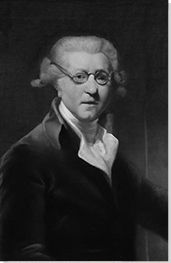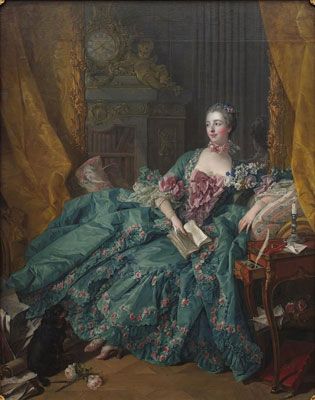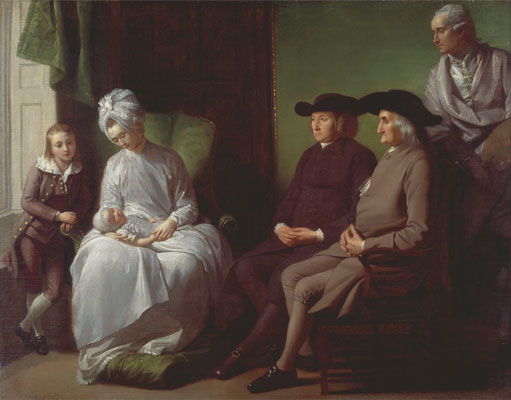Summary of Joshua Reynolds
Reynolds was the leading portraitist of the 18th century, invigorating the genre and raising its status to that of religious and historical works. Well-known and respected during his lifetime, he combined the English style of portraiture with ideas drawn from antiquity and the Old Masters to create fashionable, large-scale images of British high society as well as early celebrities including actors and courtesans. His images often included theatrical elements including colorful props and costumes, imagined pastoral landscapes, and irreverent classical symbolism. Reynolds played a central role in founding the Royal Academy of Arts, which gave artists an opportunity to display their work publicly for the first time, and as its first president, he was widely respected for his intellectual ideas and his emphasis on education, a focus that was apparent through his lecture series "Discourses on Art". The Royal Academy became an important breeding ground for new ideas and it is still a bastion of the British art scene today. Its role in promoting art and artists owes a great debt to Reynolds' early involvement and presidential tenure.
Accomplishments
- Reynolds was one of the early advocates of the Grand Manner, the style of portraiture for which he became famous and which he helped to define and popularize through his work and his public talks. The Grand Manner borrowed poses and compositions from Classical Art and Renaissance painting and sought to idealize nature rather than copying it directly.
- Later in his career, Reynolds coined the term fancy pictures to describe a style of portrait genre painting which he helped to develop. Fancy pictures often featured children in a pastoral or classical setting and the style was also practiced by Thomas Gainsborough.
- Reynolds can be seen as an early forerunner of modernism, both in his egalitarian choice of subjects and his fashionable styling of all his sitters regardless of status, but also in his removal of distracting details from his paintings, something that he warned would "dissipate the attention".
The Life of Joshua Reynolds
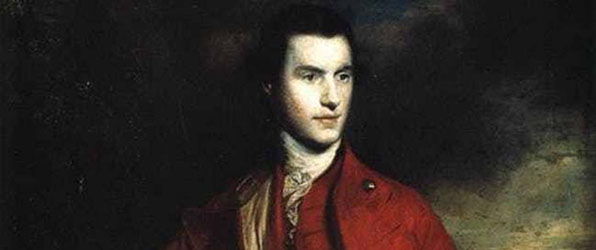
Joshua Reynolds was so experimental with color in his portraiture, that he mixed all sorts of materials with the paints to change the pigment; a method that sadly compromised the works’ longevity. As art critic Jonathan Jones said: “Today the ghostly faces of his failed experiments haunt our galleries, like gothic monsters.”
Important Art by Joshua Reynolds
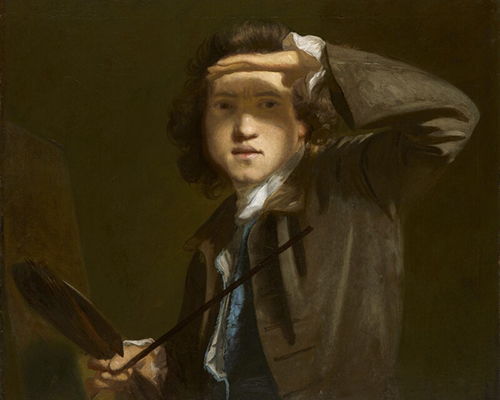
Self-portrait shading the Eyes
This painting is an early self-portrait by Reynolds; a subject he returned to often throughout his career. This was probably painted prior to his trip to Europe and in it he shows himself turning to look towards the viewer, his left hand positioned at his forehead as if helping him to see better (or shading himself from bright light?). In his right hand he holds an artist's palette and a mahlstick. As such, this work bears the distinction of being the only self-portrait in which the artist depicted himself with the tools of his profession. That he did this at a young age, demonstrates his pride in his career and the painting acts as an assertion of himself as an artist and serves as an early indication of his skill as a self-publicist. The painting was originally vertical in format and was later reduced at the top and bottom, probably in the 19th century.
The composition of the piece departs from the norms of portraiture for the period where sitters were portrayed formally and in well-established poses. This is noted by art historian Mark Hallett, who writes that, "very differently, Reynolds depicts himself as a man of action, who, raising his arm to his face as he twists away from his canvas, is caught in the moment of painting". This sense of movement and the use of a non-standard pose can be seen as an early experiment that would inform Reynolds later portraits.
Oil on canvas - National Portrait Gallery, London
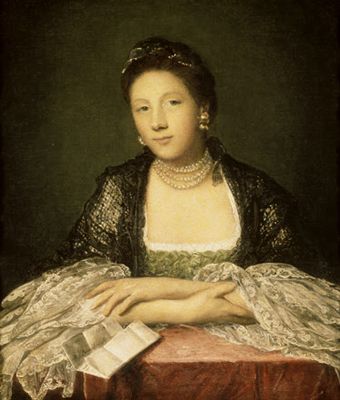
Miss Kitty Fisher
Miss Kitty Fisher features a woman wearing a fashionable gown, multiple strands of pearls around her neck, and a pearl encrusted tiara in her dark hair. Her head is titled slightly to the left as she looks keenly at the viewer. On the table in the foreground there is a partially unfolded letter which reads "My dearest Kit" and is dated "2 June 1759". Reynolds painted Fisher on a number of occasions and at first glance, one sees a portrait of an aristocratically-styled woman who is the picture of decorum and sophistication. The sitter, however, was in fact a courtesan who was famous in British society for her sexual alliances with a number of high-profile aristocrats. Reynolds subtly draws attention to her reputationby the inclusion of the letter, apparently from one of her admirers.
The work demonstrates Reynolds' eclectic choice of subjects, including those that would court controversy and shock the public. In fact, Fisher was not the only courtesan that he painted, the well-known Nelly O'Brien also sat for him multiple times. The way Fisher is depicted can be seen as a forerunner to modernism. While the subject of courtesans and prostitutes had long been depicted in art, here Reynolds does so in a new way, presenting a woman who would be known by the viewing public, boldly staring out at and confronting the viewer in an unapologetic fashion. She displays no shame about her profession. It is this same type of gaze that, years later, would cause outrage in Edouard Manet's paintings Olympia (1856) and The Luncheon on the Grass (1862).
Oil on canvas - The National Trust, Petworth House, UK
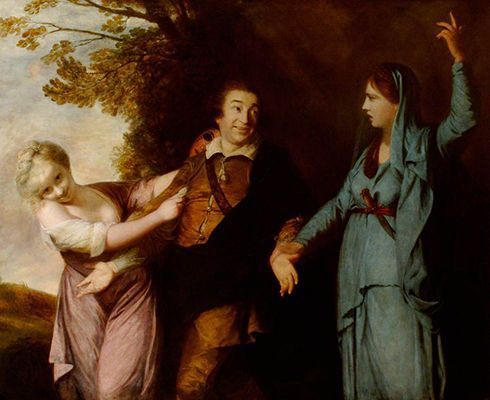
Garrick between Tragedy and Comedy
David Garrick, the famous actor, playwright, and theater manager is depicted in a pastoral setting between a blonde woman wearing a provocatively low-cut dress (comedy) and a more conservatively dressed woman in a blue robe (tragedy). Reynolds was a great admirer of the theater and his patronship also helped him to maintain his circle of contacts and gain introductions to new clients. He was a close friend of Garrick and this image references Garrick's profession as an actor showing him being pulled between the two genres of theater. This idea of a person represented or divided by different elements was utilized more than once by Reynolds and can also be seen in paintings such as Sarah Siddons as the Tragic Muse (1783-84) in which the figures of Terror and Fear lurk in the shadows.
The clothes and stylized poses of the women reflect their different roles and this is an example of Reynolds' widespread use of symbolism in portraiture. Not only do the figures embody their respective acting genres, however, but the painting also takes on a wider allusion, comparing Garrick's theatrical choice to that of Hercules. In classical mythology, Hercules had to choose between the paths of Virtue and Vice, often represented as figures in allegorical works of the period. In comparing Garrick with Hercules, Reynolds makes a humorous comment on 18th century concepts of heroes and heroism. Whilst this lighthearted approach was appreciated by many, it was seen as flippant and verging on disrespectful to the traditions of classical art by others, notably the American-British artist Benjamin West.
Oil on canvas - The National Trust, UK
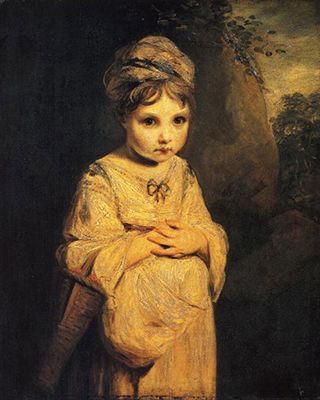
The Strawberry Girl
This work is arguably the best known of Reynolds' fancy pictures, a genre he began to paint from the 1770s. Featuring young children, such pictures often included exotic costumes and fantasy locations. This image is intended to invoke a sense of pity in the viewer and for curator Lucy Davis, "her large deep-set eyes gaze intensely at the viewer and, combined with her timid, hunched posture, create a rather pathetic effect". Reynolds often used poor children as models which if it was the case here (although the sitter is unknown) it would have helped lend an authenticity to to the sad life that the young figure is presumably meant to have led.
Strawberry sellers were a common sight in 18th century London, but were usually young women as opposed to children. Age, however, is not the only area in which Reynolds has employed dramatic license in the image. Davis further explains how, "removing the figure from an urban setting, he emphasized her isolation by painting her in front of a looming rocky outcrop. He amplified the picturesque tone of the picture by inventing an exotic costume for the girl." All of these details imbue the work with a slightly surreal and unsettling quality. Interestingly, this sense of the uncanny is heightened by the pale color palette of the piece, although this is due to fading, rather than being representative of Reynolds' artistic vision. The artist was a keen experimenter, trying out new paints and pigments and this has led to fading, blistering and cracking on a number of his works.
That Reynolds greatly enjoyed painting these fancy paintings has been well documented by his biographers. According to James Northcote, who spent years as his assistant, "so desirous was Sir Joshua to arrive at excellence, that I have known him to work days and weeks on his fancy subjects, on which he could practice every experiment at pleasure, while numbers of his portraits remained unfinished....Such was his delight in working on those fancy subjects that he was content to indulge it even at the expense of his immediate interest."
Oil on canvas - The Wallace Collection, London
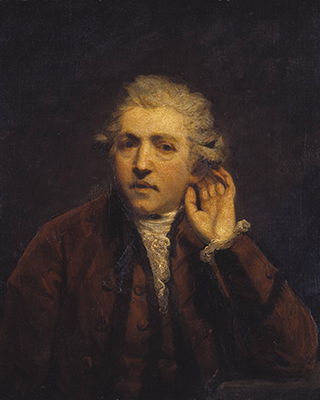
Self-portrait as a Deaf Man
In this self-portrait, Reynolds portrays himself from the waist up wearing a dark brown jacket with white ruffled shirt beneath. Set against a black background, the viewer's eye is drawn to the light shining on his face and gray hair. His left hand is raised and cupping his left ear making it appear as if he is struggling to hear something. One of many self-portraits the artist created during his lifetime, here we see the deeply personal, auto-biographical way he chose to depict himself. By drawing the viewer's attention to his left ear, he is giving visual manifestation to the hearing loss he struggled with in the later years of his life. While Reynolds often created a theatrical staging for many of his portrait sitters, with his own portraits rather than paint a highly idealized version of himself, he painted a brutally real assessment.
This work shows Reynolds' mastery over the use of light and shading in his portraits. The black background of the painting and his clothes stand in sharp contrast to the light that washes over his face and hand serving to draw attention to the most important aspect of his painting; the ear. Alive with Baroque energy and the assured use of chiaroscuro it demonstrates the influence of artists like the Italian master Caravaggio on his art.
Oil on canvas - Collection of the Tate, United Kingdom
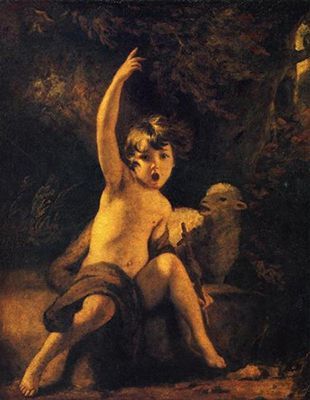
St John the Baptist in the Wilderness
Here, Reynolds has depicted the biblical figure of John the Baptist as a young child in the wilderness and the work highlights three key characteristics of Reynolds' art. First, while not his primary subject matter, it provides a fine example of Reynolds' religious paintings of which the figure of John the Bapist was one of his favorites to depict. The wild gesturing of John heralds the coming of Christ, who is symbolically represented by the lamb beside him and his impending sacrificial death through the cross John holds. Secondly, it shows the influence of the Italian Old Masters on Reynolds' work complete with the complex shading reminiscent of Caravaggio and references to Raphael's painting of the same subject from 1518-1520. Lastly, depicting John the Baptist as a child, allowed Reynolds to create a fancy picture, something which he enjoyed doing and which, by this time in Reynolds' career, were developing a solid reputation. Curator, Lucy Davis describes how, the choice of depicting John the Baptist was, "a subject which enabled him to pay homage to Old Master religious imagery, both in terms of subject matter and in composition and technique. However, with characteristic ingenuity, Reynolds transformed the composition from a purely devotional image to one which aligned closely with his secular fancy pictures of children."
Oil on canvas - The Wallace Collection, London
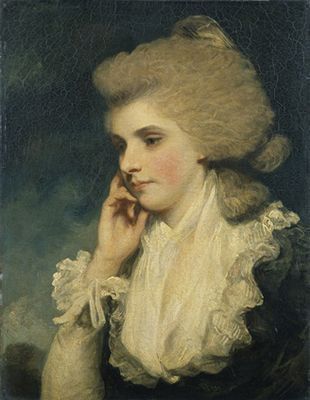
Frances, Countess of Lincoln
This work is a fine example of the Grand Manner style, a type of portraiture that Reynolds developed and built his career upon. Often these paintings were of family members of devoted patrons and this is true for this painting. Frances Seymour-Conway was the daughter of the Marquess of Hertford a great supporter of the artist. The work was one of a pair he created of Frances and her sister Elizabeth and highlights his mastery and command of paint as well as his ability to capture the sophistication of British high society fashions. According to curator Lucy Davis and art historian Noémi Duperron, "this pair of portraits emphasizes the two women's stylishness of hairstyle and dress...To convey the light, delicate character of the frilled collars as well as a sensation of their transparency, Reynolds has layered different consistencies of paint in these portraits, including strokes of liquid paint...He clearly worked quickly in painting the two sisters' clothing, often using a wet-in-wet technique."
Reynolds' ability to capture the humanity of his sitters is also present in this work. The way Frances is portrayed reflects her recent widowhood with her pose drawn from Italian painting where it conveyed both thoughtfulness and melancholy. In depicting her in this manner, Reynolds not only captures her grief but presents a picture of ideal femininity represented through her fashionable presentation and appropriate depth of feeling.
Oil on canvas - The Wallace Collection, London
Biography of Joshua Reynolds
Childhood and Education
Joshua Reynolds was one of eleven children born to Theophilia Potter and Samuel Reynolds. His father was a clergyman and master of Plympton Free Grammar School in Plymouth and had previously been a fellow of Balliol College, Oxford. Consequently, Reynolds grew up in a comfortable and educated household and he was encouraged to pursue both his academic and artistic interests.
Early Training
Reynolds' art training began in 1740, at the of age seventeen, when he traveled to London to begin an apprenticeship with the fashionable portrait painter Thomas Hudson. After three years of study, Reynolds began working as a portrait artist in London and Devon. In an attempt to further his artistic development, and following in the tradition of many other artists of the time, in 1749, Reynolds left for a multi-year trip to Europe to study the works of the Old Masters. He visited cities including Florence, Naples, Rome, and Paris, and painted portraits of the wealthy men and women he met there. Whilst in Rome, Reynolds caught a severe cold which left him partially deaf and laid the foundations for hearing problems later in his life. As a result of the incident he began to carry a small ear trumpet which appears in some of his portraits.
Mature Period
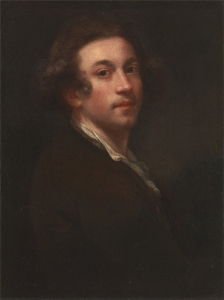
Upon returning to London in the fall of 1752, he established what would become a highly successful portrait business. Besides great talent, Reynolds' success was due, in no small part, to his easy nature which allowed him to establish friendships with important people and gave him access to upper-class society. An early example of this was his relationship with Commodore Augustus Keppel who, not only helped to sponsor Reynolds' trip to Europe but who also introduced him to future sitters, including, the Marchioness of Tavistock and the Duke of Cumberland. According to historian Richard Wendorf, "these important ties, forged so early, held him in good stead throughout his career, often producing a ripple effect in polite society as one introduction, one commission, led to yet another".
The growth of Reynolds' reputation as a portrait artist allowed him to move to a larger house in Leicester Fields (now Leicester Square) in 1760. Here, he built a studio which he opened to the public so they could see his work as well as his growing collection of paintings from other artists. It was also at this time that Reynolds began to take on pupils and apprentices. While some such as Giuseppe Marchi stayed with him for many years, the relationship he had with these young men has been the subject of much discussion. One student, James Northcote, an artist and one of Reynolds' earliest biographers, described his lack of interest in his students, noting that "He never conversed. If he made an observation, he did it in a hasty, half-pettish manner, and seemed to employ as few words as he could." Reynolds himself often expressed concern about students, once stating, "indeed I have never been sure, that I understood perfectly what they meant, and was not without some suspicion that they had not themselves very distinct ideas of the object of their enquiry". Whilst he may have distanced himself from his students, his relationships with fellow artists was the opposite and he developed lifelong friendships with many of his contemporaries including Angelica Kauffman and Gilbert Stuart; both of whom painted portraits of Reynolds.
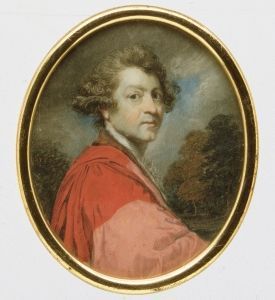
Indeed, Reynolds had an active social life with a large and welcoming circle of friends, stating that, "everybody has their taste. I love the correspondence of viva voce over a bottle with a great deal of noise and a great deal of nonsense." His large dinner parties were legendary and according to Wendorf, "Reynolds enjoyed inviting lively guests who were often of very different opinions" and he "ensured that this conversation would tumble forth by insisting on an unusual informality and even an element of social chaos at the table". He also belonged to many clubs including one centered around gambling and another around literary pursuits.
A lifelong bachelor, it is believed that Reynolds may have had numerous affairs with wealthy women, some of whom were his sitters. He did not live alone, however, and instead employed his sisters and, later, his nieces as housekeepers. It has been suggested that Reynolds was difficult to live with and a number of historians have written of his demanding nature with his family and his stingy manner when it came to paying bills and fulfilling household needs.
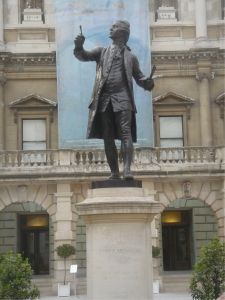
Reynolds' success resulted in many honors. In 1768 when King George III brought into existence the British Royal Academy of Arts, Reynolds was one of the 34 founding members which also included Thomas Gainsborough, Benjamin West, and Angelica Kauffman. Reynolds was elected as the first president and in this role he began to deliver his famous Discourses on Art lectures about the practice of art. A year later he was granted a knighthood on April 21, 1769. Interestingly, despite this honor by the King, Reynolds begrudged the fact that he had never been asked to paint the King's portrait and therefore made it a condition of his acceptance of the Presidency of the Royal Academy that he was allowed to paint the monarch.
Late Period
Whilst continuing to create many of the Grand Manner portraits for which he is best known, Reynolds also developed a new style of work which became popular. These portraits featured children in highly stylized, almost theatrical settings and poses and became known as fancy pictures. In 1778 the first seven of his Discourses were compiled and published. He was also appointed as Principal Painter in Ordinary to King George III in 1784, after the death of the King's favorite painter Allan Ramsay, but was not asked to paint anything in this role, a situation that he resented bitterly. Writing to James Boswell and referring to his inauguration as court painter, Reynolds noted that: "If I had known what a shabby miserable place it is, I would not have asked for it; besides as things have turned out I think a certain person is not worth speaking to, nor speaking of". This last barbed comment is probably a reference to the King himself.
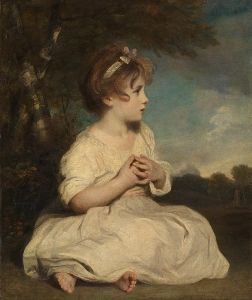
In 1789 Reynolds was involved in the Bonomi affair at the Royal Academy. The scandal involved his proposal of Giuseppe Bonomi for election to the Academy and for the position of Professor of Perspective. Many members, however, were opposed to the appointment of an Italian to the position and questioned Reynolds' motives, thinking that he was acting with the purpose of pleasing one of his patrons. Reynolds resigned from the Academy in anger but the public backlash over his leaving was great and at the request of the King he returned to office and served as President for the rest of his life.
Reynolds' health declined sharply in his last years. He struggled with hearing loss and and then devastatingly for an artist, in 1789, he lost the vision in one of his eyes which forced him to stop painting. Three years later he died as a result of liver failure.
The Legacy of Joshua Reynolds
Joshua Reynolds was hugely prolific, producing over 2,000 portraits in his career. He is considered one of Britain's greatest artists, revolutionizing the art of portraiture and raising its status. He had a profound impact on both his contemporaries and successors and his style was emulated by artists including Hugh Barron, John Singleton Copley, and James Northcote.
Reynolds demonstrated that portraiture could be more than simply the act of formally capturing a sitter but rather a highly staged and entertaining work that spoke of a person's character and livelihood. Additionally, by painting courtesans and actors in the same style as wealthy aristocrats and patrons, he expanded the notion of what subjects could be worthy of depiction in fine art and in doing so he preempted the ideas of modernism. As such, his paintings laid the foundation for more recent risk-taking portrait painters, which are now reflected in the inventions of luminaries such as Lucian Freud and John Currin.
Through his role in founding the Royal Academy and his subsequent, life-long presidency, Reynolds had a significant impact on theories and education practices within the art world. His series of fifteen lecture, Discourses in Art are still in print today and have been widely translated, heavily influencing artists such as JMW Turner. Conversely, William Blake strongly disagreed with some of Reynolds' ideas, and used his antipathy as his basis to form his own radical views.
Influences and Connections

- Edmund Burke
- Richard Edgcumbe
- Commodore Augustus Keppel
- Richard Seymour-Conway
-
![Thomas Gainsborough]() Thomas Gainsborough
Thomas Gainsborough -
![Benjamin West]() Benjamin West
Benjamin West - John Singleton Copley
- Giuseppe Marchi
- James Northcote
- Edmund Burke
- Richard Edgcumbe
- Commodore Augustus Keppel
- Richard Seymour-Conway
